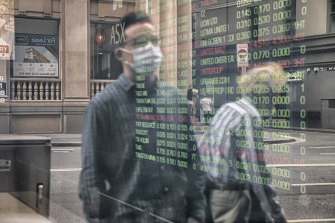It’s all a sharp turnaround from earlier in the pandemic, when central banks worldwide slashed rates to record lows and made other moves that propped up prices for stocks and other investments in hopes of juicing the economy.
Such expectations are also sending US bond yields to their highest levels in more than a decade. The two-year Treasury yield shot to 3.23 per cent from 3.06 per cent late on Friday after touching its highest level since 2007, according to Tradeweb. It’s more than quadrupled this year.
The 10-year yield jumped to 3.34 per cent from 3.15 per cent, and the higher level will make mortgages and many other kinds of loans for households and for businesses more expensive. It has more than doubled this year and touched its highest level since 2011.

The ASX is facing heavy falls on Tuesday. Credit:Louie Douvis
The gap between the two-year and 10-year yields has also narrowed, a signal of dropping optimism about the economy in the bond market. If the two-year yield tops the 10-year yield, some investors see it as a sign of a looming recession.
The pain for markets was worldwide as investors braced for more aggressive moves from a coterie of central banks.
Loading
In Asia, indexes fell at least 3 per cent in Seoul, Tokyo and Hong Kong. Stocks there were also hurt by worries about COVID-19 infections in China, which could push authorities to resume tough, business-slowing restrictions.
In Europe, Germany’s DAX lost 2.4 per cent, and the French CAC 40 fell 2.7 per cent.
Some of the biggest hits came for cryptocurrencies, which soared early in the pandemic when record-low interest rates encouraged some investors to pile into the riskiest investments. Bitcoin tumbled more than 17 per cent from a day earlier and dropped to $US23,222, according to Coindesk. It’s back to where it was in late 2020 and down from a peak of $US68,990 late last year.
Bears hibernate, so bears represent a market that’s retreating, said Sam Stovall, chief investment strategist at CFRA. In contrast, Wall Street’s nickname for a surging stock market is a bull market, because bulls charge, Stovall said.
The last bear market wasn’t that long ago, in 2020, but it was an unusually short one that lasted only about a month. The S&P 500 got close to a bear market last month, briefly dipping more than 20 per cent below its record, but it didn’t finish a day below that threshold.
This would also be the first bear market for many novice investors who got into stock trading for the first time after the pandemic’s start, a period when stocks largely seemed to go only up. That is, they did until inflation showed that it was worse than just a “transitory” problem as initially portrayed.
“The best thing people can do is to not panic and don’t sell at the bottom…and we’re probably not at the bottom.”
Randy Frederick, managing director of trading and derivatives at the Schwab Center for Financial Research,
Michael Wilson, a strategist at Morgan Stanley who’s been among Wall Street’s more pessimistic voices, is sticking with his view that the S&P 500 could fall to 3,400 even if the US economy avoids a recession over the next year.
That would mark another roughly 10 per cent drop from the current level, and Wilson said it reflects his view that Wall Street’s earnings forecasts are still too optimistic, among other things.
Loading
With soaring price tags at stores souring sentiment for shoppers, even higher-income ones, Wilson said in a report that “the next shoe to drop is a discounting cycle” as companies try to clear out built-up inventories.
Such moves would cut into their profitability, and a stock’s price moves up and down largely on two things: how much cash the company is generating and how much an investor is willing to pay for it.
The Fed’s moves factor heavily into that second part because higher rates make investors less willing to pay high prices for risky investments.
Economists at Deutsche Bank said they expect the Fed to hike rates by larger-than-usual amounts on Wednesday, again in July, then again in September and a fourth time in November. Just a week ago, before Friday’s wake-up call of an inflation report, Wall Street was debating whether the Fed may take a pause on rate hikes in September.
AP
The Market Recap newsletter is a wrap of the day’s trading. Get it each weekday afternoon.








